Avery Crounse’s Eyes of Fire (1983)
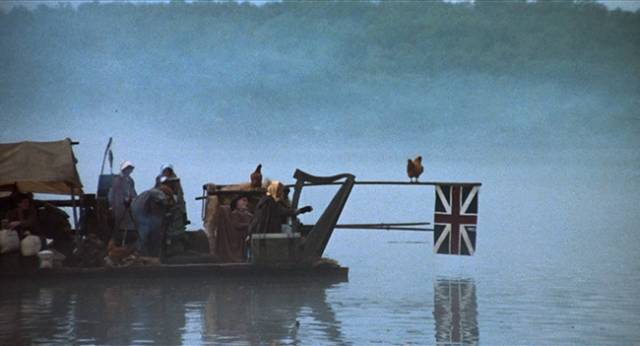
I had been looking forward to Severin’s folk horror box set for quite a ling time, largely because I was eager to see Kier-la Janisse’s expansive documentary about the genre, Woodlands Dark and Days Bewitched. In support of the documentary, Severin had gathered nineteen features and numerous shorts as perhaps the most comprehensive supplementary package ever compiled – a globe-spanning survey of the genre so richly explored by Kier-la. I was familiar with half-a-dozen of the films included, but the rest were unknown to me, not least the first feature in the set, Avery Crounse’s Eyes of Fire (1983).
Given how many movies have been made in the century-plus history of cinema, it’s not surprising that there are a seemingly endless supply of films I’m unfamiliar with, even from decades of reading, but Crounse’s first feature has been packaged (and received) as the resurrection of a significant, virtually lost film. Severin have simultaneously released it as a stand-alone title, and the disk has substantial extras, including an alternate, longer cut.
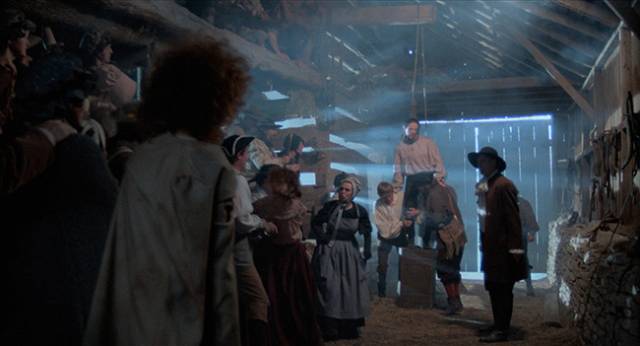
I confess that on first viewing, my response was somewhat clouded by frequent memories of Robert Eggers’ The Witch (2015), a film with which it shares a number of similarities. Somewhat unfairly, I couldn’t help seeing Eyes of Fire as a cheaper, less-accomplished film than The Witch. In fact, it was only as I watched the alternate cut, Crying Blue Sky, that I was able to shake off the association and connect fully with Crounse’s work.
But first, the similarities: both films are set during early colonial times; both have small groups driven from a frontier community because of religious differences; both conflate the border between a European settlement and the “wilderness” as a porous region in which reason and magic intermingle with dangerous consequences. In Eggers’ film, the group is a family, with the focus on an adolescent girl whose own transition from childhood to sexual maturity unleashes the mystical energy embodied in the wild land. In Crounse’s movie, the group is larger and less cohesive than a single family, and although there is an adolescent girl, she’s less central to the forces unleashed.
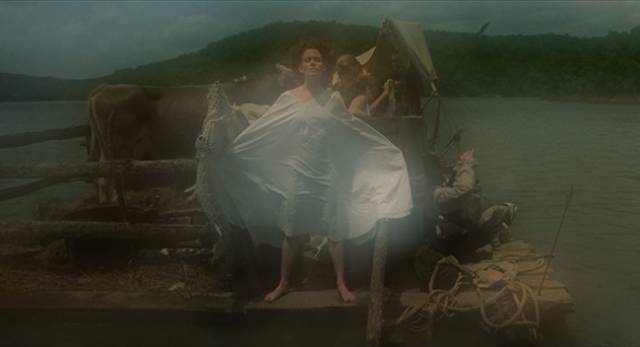
The nature of the conflict which triggers the groups’ exile is different in each film: in The Witch, it stems from a clash between different extremes of Puritanism, a doctrinal dispute and a father’s refusal to accept the village elders’ particular type of religion. In Eyes of Fire, however, it stems from newly-arrived Pastor Will Smythe (Dennis Lipscomb)’s unorthodox attitudes, particularly with regard to sex. The community is outraged when Eloise Dalton (Rebecca Stanley), the wife of a trapper who has been away for a year, moves in with Smythe and his ward, Leah (Karlene Crockett), a strange girl with a habit of slipping into trances and speaking in tongues.
When the villagers decide to lynch Smythe as a witch, it seems that Leah actually does have powers, breaking the rope at the crucial moment. Smythe’s friend Jewell Buchanan (Rob Paulsen) and another man, Calvin (Will Hare), arrive with muskets and the entire group – Smythe, Eloise, Leah, Jewell, Calvin, Eloise’s daughter Fanny (Sally Klein), Jewell’s wife Margaret (Kerry Sherman) and daughter Cathleen (Caitlin Baldwin), and Calvin’s wife Sister (Fran Ryan) – steal supplies and the village’s ferry and drift off down the river into Shawnee territory, where the French have established their own domain.
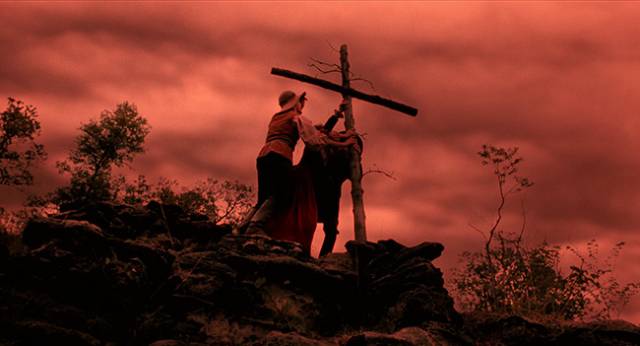
Back at the village, Eloise’s husband Marion Dalton (Guy Boyd) returns after his year of travelling and, hearing what has happened, sets out to retrieve his daughter. Meanwhile, the group on the river have been attacked from the shore, with Calvin being killed. Abandoning the ferry, they head into the woods with no idea where they’re going. During an intense encounter with a small group of Shawnee and French trappers, Marion shows up to defuse the situation – he knows the Shawnee and speaks their language, but doesn’t trust the French, managing to shoot all three. Unfortunately, Eloise shoots one of the Shawnee, so Marion’s effort is undermined; they’ll soon be back to exact revenge.
While this is going on, Leah has discovered a strangely surreal place nearby, with trees and ground covered with pristine white feathers. Marion recognizes this as a mystical barrier, a warning not to proceed into the valley below. He knows that the Shawnee won’t follow them, but he also knows that this is because there’s something to fear ahead. There are forces in the valley which may pose a danger to the group, but they decide to take their chances and enter the valley.
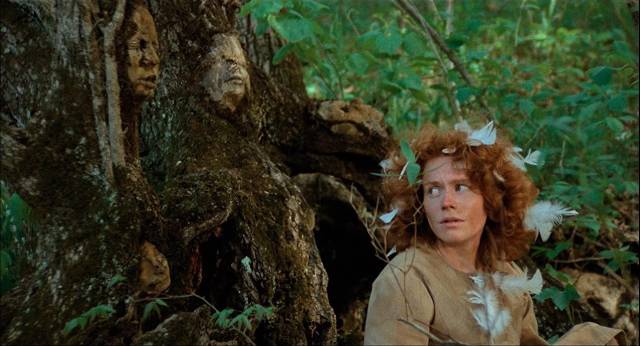
While the forest in The Witch represents ancient pagan forces which align with the daughter’s burgeoning sexuality, infusing her with a power counter to the rigid dogma of her father and the other villagers, the valley in Eyes of Fire is infused with a malevolent energy fed by the murderous conflict between Native and European cultures; the blood-soaked ground has birthed a “witch” (Russell James Young Jr), a forest spirit which captures and absorbs anyone who intrudes into its domain. Although there are pagan and Christian elements in the story, the larger theme of Eyes of Fire is concerned with the violence of colonialism and Manifest Destiny.
Marion, who has neglected his family in his exploration of this new world, understands the forces confronting them, but the arrogant religious hypocrite Smythe gradually falls apart as his smug certainties prove ineffectual in the face of genuine mystical forces. Leah, on the other hand, comes into her own, in harmony with the energy surrounding them and eventually becoming the group’s protector as she assumes the role of light against the witch’s darkness.
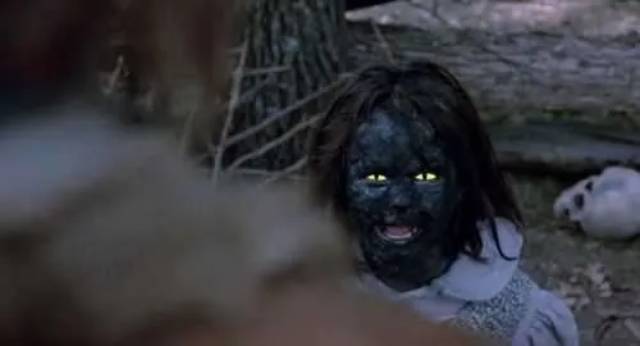
Crounse, a well-regarded still photographer here making his first movie, gives Eyes of Fire a leisurely pace appropriate to the period, lingering on images of the primal landscape. He uses various photographic techniques from his stills work to evoke the occult forces at play, manipulating the image texture, exploiting the ability of photography to simultaneously capture the real while making it expressively unfamiliar. On several occasions, he uses editing to suggest the supernatural, in particular displaying Leah’s powers by the simple use of flash cuts to an event just before it happens. At various times, spirits of dead settlers appear and disappear in the meadow in front of the group’s shelter, and faces of the dead are embedded in the bark of trees in the surrounding woods. The Witch itself seems half human, half tree, a dark, knotty figure which rises from the earth and sinks back again.
I was surprised to find that these elements are greatly reduced in the alternate cut, Crying Blue Sky. Although it runs some twenty minutes longer, quite a few scenes are shorter and the supernatural elements are used more sparingly – there are none of Leah’s flashes of precognition, and fewer of those optical effects once the group reach the valley. The added length makes room for a bit more character development – Sister’s role is expanded to develop the theme of willful blindness which is central to Smythe’s experience of the world – while it shifts attention slightly away from an emphasis on the film’s status as horror and more towards its meditation on the costs of colonialism, both to its victims and its perpetrators.
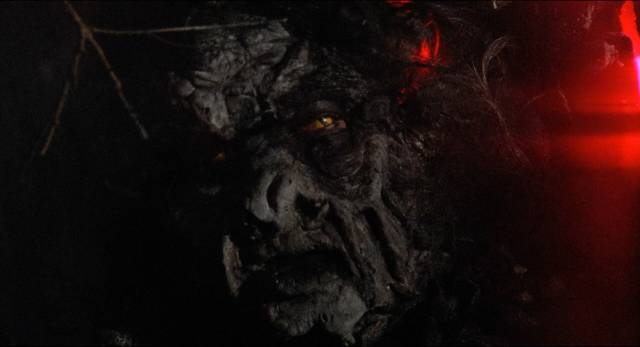
Crounse made the changes after seeing the original, longer version with an audience whose reaction signalled certain weaknesses. It’s almost always difficult to gauge the effect of this kind of thing when having immediate access to both variants, and having seen the shorter Eyes of Fire first I did miss those supernatural details when they failed to show up in Crying Blue Sky – the groundwork for Leah’s transformation into a powerful supernatural force is largely missing; the menace of the young Shawnee child who is taken in is immediately suggested in the later version because Leah clearly sees that she is no ordinary child but rather another malevolent spirit, something which is shown only once in the earlier version near the end. I found myself drawn in more deeply by Crying Blue Sky (without the later version’s narrative frame with the children telling the story to a skeptical French officer, it begins more enigmatically) and while watching imagined a combined version in which the changes made to Eyes of Fire, except for that frame, were simply incorporated … as they stand now, both films need to be seen to fully appreciate the world Crounse evokes.
*
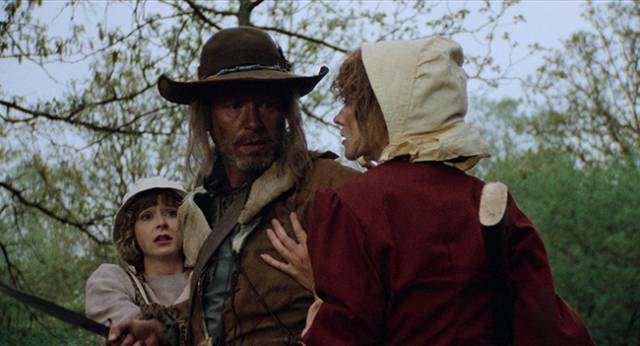
Eyes of Fire gets a 4K restoration from the original negative and for the most part looks excellent, with a lot of detail even in really dark scenes; Crying Blue Sky is a 2K transfer from Crounse’s personal 35mm answer print, not surprisingly looking a bit less impressive (those dark scenes are murkier), but still very watchable. Both films’ soundtracks are fine, displaying Crounse’s subtle use of effects and ambiences to give the narrative an otherworldly feel.
There’s a commentary on Eyes of Fire from Colin Dickey, author of a book on American folklore (which I haven’t listened to yet, but is reportedly critical of some aspects of the movie), plus a half-hour conversation between Stephen Thrower and Crounse which covers the filmmaker’s background in stills photography, the experience of switching to movies, the actual making of the film, and the reasons for making the changes which transformed Crying Blue Sky into Eyes of Fire.
There are also three short films: an animated version of The Legend of Sleepy Hollow (Sam Weiss, 1972); Transformations (Barbara Hirschfeld, 1972), an impressionistic black-and-white piece about contemporary suburban witches meeting to conduct a ceremony; and Backwoods (Ryan Mackfall, 2018), an adaptation of H.P. Lovecraft’s 1920 short story “The Picture in the House”.
Comments